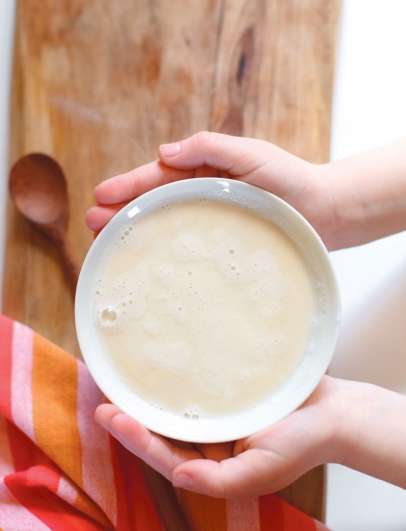Sourdough Starter
Dear Sourdough, I Love You.
I’m not going to lie: this issue has been a real stumper for me. As we know, I’m not a chef, cook, or person that enjoys laboring over my food. When the theme of fermentation was thrown out, my response was, “oh boy.” I was intimidated. I went through the short list of anything I remotely connected with fermentation—beer/alcohol, kimchi, sauerkraut, and kombucha—and came up empty-handed. Due to many additional food allergies outside of gluten, I steer clear of most ethnic foods, which means I’m not super familiar with dishes like kimchi. (I’ve heard I’m missing out.) Sauerkraut is not my homeboy and my attempts to find a kombucha I like have proven futile outside of a homemade raspberry brew I stumbled across at a Denver farmer’s market while on vacation. Then I wondered, “what’s left? Talking about apple cider vinegar?” You’ll be relieved to know that after consulting several fellow gluten-free (GF) eaters, the Internet, some medical journals, and Pinterest (duh), I’ve managed to become more educated about fermented foods and their benefits. Turns out, fermented foods help to heal our gut and give our bodies the right amount of fighting bacteria that will help keep us healthy and feeling good.
My personal buy-in came when searching for GF fermented foods and I came across how to make your own GF sourdough starter. I nearly cried. My mom used to make homemade sourdough bread on a regular basis and I can still taste it in my dreams at night. She still has a portion of sourdough starter in her refrigerator that’s been passed down through 4 generations. That means my great-grandma crafted a sourdough starter that has been kept “alive” for something like a century! How cool is that?! It should be no surprise to you by now that I have a sentimental and emotional relationship with food. Discovering that it was possible to successfully make a GF version of sourdough starter and bread became the light of my life.
Surprisingly, crafting your own starter from scratch requires very few ingredients and is ready to use in as little as 5 to 7 days. Also surprisingly, it can be annoyingly high maintenance to keep up with due to its “feeding schedule.” I found a lot of different recipes and the general consensus seemed to follow the principles of flour + water + time = yeasty sourdough starter.
Did you know that sourdough actually has health benefits? Sourdough contains a “good” bacteria called lactobacillus which is a result of the fermentation process and creates lactic acid. Lactic acid helps make digestion of starch much easier on your gut. Lactobacillus also helps feed bacteria that are already in your gut, which means your overall digestion can improve and join forces with your immune system to fight off “bad” bacteria. Thank you, bread!
INITIAL STARTER:
(Sources: dontwastethecrumbs.com, wholenewmom.com)
½ cup brown rice flour
½ cup cold (or room temp) filtered water
Medium/Large bowl
Combine flour and water in your bowl until smooth. (The consistency will be thin and you’ll begin to wonder if this will even work.) Lightly cover bowl with a lid in such a way to allow for airflow (cheesecloth and a rubber band are also a great option). Place bowl in a warm area that is free of disturbance: windowsill, pantry, your closet, etc.
FEEDING STARTER:
For best results, you want to feed the starter 3 times a day at roughly the same time each day and at even intervals. (I know. Who has the time?!) One suggestion was 6 A.M. (yeah, right), 2 P.M., and 10 P.M. You’ll be doing this for the next 7 days so be sure you can commit to this lifestyle before beginning.
At each feeding, grab your bowl and mix in ½ cup of flour and enough water to mix it well (try ¼ to ½ cup of water at a time). Stir it until smooth again, re-cover, and place bowl back in its happy place. Repeat in 8 hours.
NOTES:
• Your starter may bubble and it may not. It may take a few days or it may not bubble at all. Most likely it will at least be frothy at some point.
• Your starter may start to smell pretty rank around the second, third, or fourth day. What you smell is “wild yeast” dancing with the brown rice flour. Your starter is not contaminated; it’s just getting busy. The smell should be gone or at least be pleasant by the sixth or seventh day. (Pleasant means you should smell something like sweet yeast or wine. If it smells sour or rancid, you need to scrap the project and start over.)
• Around day 4 or 5, you should start seeing a dome shape on top of your starter a few hours after feeding it. That’s your fermentation party!
• If your starter gets too big for its britches, simply syphon out your starter to a larger container or divide it between containers to allow for growth. Continue to feed it per the schedule using ¼ cup of flour instead of ½ cup.
• If liquid collects on the surface of your starter you can mix it in at your next feeding or pour it off and use water. Whatever, man.
• Once completed, you can refrigerate your starter and feed it once a week. My mom kept hers in a big glass jar with a piece of wax paper over the top and a jar ring to hold the paper in place.
• Gluten-free recipes for sourdough bread typically require around 1 cup of sourdough starter. It doesn’t seem to matter if your recipe uses different flour than your starter. The starter seems able to tolerate almost any combination of GF flours. Hooray!
Too much work? I understand. Luckily, Ener-G brand is now making a gluten-free sourdough bread! Check out the frozen section of your grocery store or you can also purchase it online.
What fermented foods do you like to eat? What kind of luck have you had fermenting your own food or beverages? I’ d love to hear from you! Holler at me : edibleokc@gmail.com or on Twitter: EdibleOKC_GF





